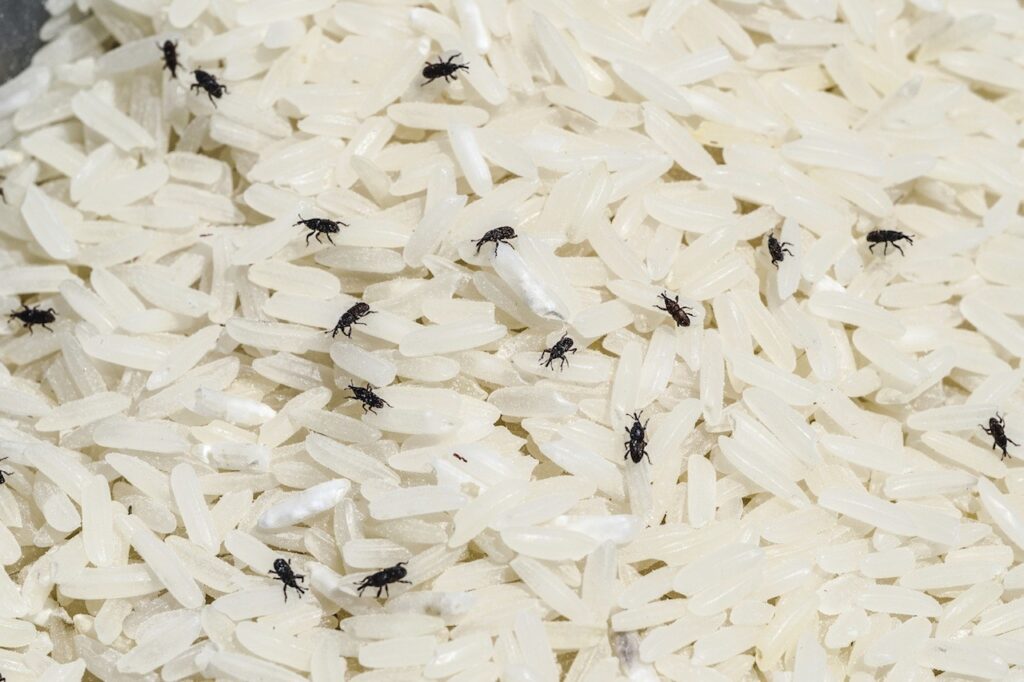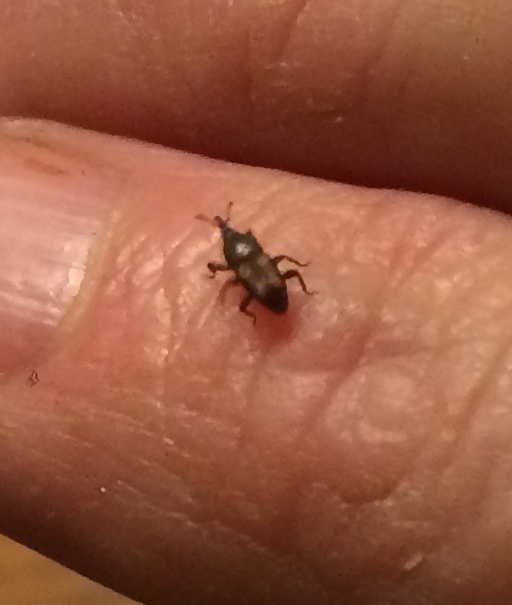
Amassing an emergency supply of rice is easy. Keeping it safe from pests can be a challenge. Rice weevils could compromise your stash of rice and move into other stored grains. Here are some tips on prevention and remediation.
This blog post started with the discovery of rice weevils in my rice canister. I was going to boil some rice for supper a few weeks ago. When I opened the canister, I saw little black specks – moving specks. I had rice weevils! They were in a sealed glass canister: not entirely airtight, but close.
Had they come in from my bulk-supply bucket? We rotate supplies, taking a bag of rice from the bucket as needed, and replacing it with another from the store. The rice in the canister was the last of one of those supply-bucket bags. Immediately, I ran down to check out my bucket of rice. It was a huge relief to see that none of my stored bags showed any signs of weevils.
To kill off everything in the contaminated rice, I poured the grains into aluminum foil pans, covered them with aluminum foil, and baked them (we already had the oven going for supper). The food loss was small: only a couple of cups of rice. The baked weevil-rice became chicken food. A few bugs are actually a plus, to them.
Where did they come from? How did they get into my rubber-gasketed glass canister?
Likely, they came in with the grain. Rice weevils (Sitophilus oryzae) are only an eighth of an inch long, black, with a snout. If you look closely, you’ll see four faint orange patches on their backs. Their normal habitat is a rice field.

They feed on the grains of rice out in the field. It’s pretty near impossible to harvest rice without sweeping up a few weevils in the process. Food producers here in the U.S. are pretty stringent about cleanliness, but some are still bound to slip through.
Invisible Invaders
As part of their life cycle, the female weevil chews a tiny hole into a rice grain. She lays one egg in the hole and seals it with a white waxy substance. That egg can lie dormant for a long time. Under the right conditions, the egg incubates and hatches. The tiny white grub eats the inside of the rice grain. Detecting an egg dent or a small white larva inside a white grain of rice is nearly impossible. It is certainly not practical on an industrial scale.
Sleeper Cells
Being a semi-tropical insect, rice weevils go dormant at temps below 60°. Since most peoples’ houses are usually only a little warmer than that, weevils develop much more slowly. This is how you could have had rice weevil eggs all along but never knew.
I’d never seen rice weevils before. The unusually hot and humid late days of summer we had here in N.H. must have provided the climate they liked, so they got active.
What To Do?
Once you spot a weevil infestation, it’s a good idea to check the rest of your stock. Rice weevils are reportedly not super-fussy eaters. They will bore holes and lay eggs in wheat berries, rye, whole kernel dry corn, pasta, dry beans, and even corn flakes. Check all the dry whole-kernel stocks you’ve got – especially near the discovered infestation.
Cardboard or paper packaging (like the ‘sacks’ flour comes in) will not stop the weevils. Check it all. If you caught an infestation early enough, getting rid of the adults and infested grain (and the eggs or larvae inside them) may take care of it. You will want to recheck frequently to make sure you didn’t miss anything.
Going Overboard
One article I read by some lady in Washington said how, when she discovered weevils in her rice, she threw away every food item in her kitchen – to be extra sure she got rid of any possible lingering pests. Some pest control websites suggest the same. If you’ve got only two or three days of food in the house – as is the national average, they say – perhaps throwing it all out isn’t that big of a loss. But, if you’ve got 25 lb. buckets of rice, beans, and wheat, throwing it all away – just to be safe – isn’t a practical solution.
Dangerous Bugs?
Rice weevils pose no health risk to humans. They neither bite nor sting, nor are known to be a vector for any diseases. They are also non-toxic, so you could eat them, though few want to. They DO compromise your stored food, and if left unchecked, could turn your emergency supply of grain-carbs into a bag of bug protein. Not a savory trade.
What To Do?
If you were in dire straits (lockdown, bug-out, etc.) where throwing the food away was not an option, you can put the rice in a pan of water. Weevils float, but the rice does not. Skim off the weevils and try not to think about any tiny eggs within some rice grains.
How To Prevent Rice Weevil Infestations
There are two basic approaches: kill them with cold or kill them with heat. While the eggs and larvae can go dormant in cool temperatures, they cannot survive severe cold. Expose your rice to 0°F for three days, and it should kill off any eggs and larvae. Or heat your rice to 140°F for 15 minutes. Be sure to check the center of your rice mass (like with a meat thermometer) to be sure the center got up to 140° too.
So, baking my weevil-rice at 350° for 20 minutes was probably overkill. Oh well.
What About Oxygen Deprivation?
One of the common prepper techniques for bulk food storage is the sealed mylar bag with oxygen absorbers. Some sites say this will kill any weevils. However, weevils are tiny bugs. They do not need much oxygen. One woman wrote about seeing active weevils inside her airtight container. Replacing the air inside a mylar bag with nitrogen would do the trick, but few do this. If you put in more oxygen absorber than the charts recommend (like using 2000 cc where it calls for 1500cc), all of the oxygen will be absorbed, leaving nothing but nitrogen.
Don’t Skimp
If you do not put in quite enough oxygen absorber for the bag’s volume, there would still be a small amount of oxygen present. Dormant tiny bugs consume very little oxygen. They can wait you out.
Good Storage Habits
• Check food for signs of insects at the store; make sure packaging is intact.
• Transfer food for long-term storage to glass, metal, or plastic containers with tight-fitting lids.
• Empty a container first before adding new stock. Don’t leave a little of the old rice behind to infect the new.
• Keep bulk grains in a cool, dry place. The rice canister on my counter was NOT a cool, dry place this summer.
• Use older packages of food before newer ones: Write dates on things. First in, first out.
Epilogue
Ever since that first encounter, I’ve checked my stocks for any sign of adult weevils. As we enter the colder months, another infestation gets less likely. When the deep cold of winter comes, I intend to set my bulk storage buckets outside a while to let the natural cold kill off any lurking larvae. I don’t want anything but me eating my stored food.
—

I put rice flour pastas into the freezer for 72 hours so far stocks are ok
I wish I had room in my freezers to do this. Too chocked full of everything else. In a few months, a New Hampshire winter will be my extra freezer. 🙂
Thanks for the comment!
I found rice weevils in a 25lb bag of rice. I poured it from from one pan to another slowly with a fan blowing across it and managed to get them all out. I then vacuum sealed it in 5lb bags. So far no more weevils.
I’ve never seen or experienced weevils before but we have a lot of rice and beans put back. I froze the rice for up to a week in our deep freeze, even the fifty-pound bags before vacuum sealing in mylar. I didn’t realize they could be in the beans though so hopefully the oxygen absorbers will take care of any if they’re in there. I’m a little concerned because I only used 300 cc for one-gallon mylar bags.
Hey Brian,
Your stored beans are probably fine. Rice weevils will move into other dry grains, beans, nuts, pasta, etc. after they get out of their original infestation spot. They start out in rice. Freezing your bags of rice for a week will have killed any grubs or eggs so your rice will be okay. Do you freeze your other dry bulk items? Wheat berries, beans, flour, etc.?